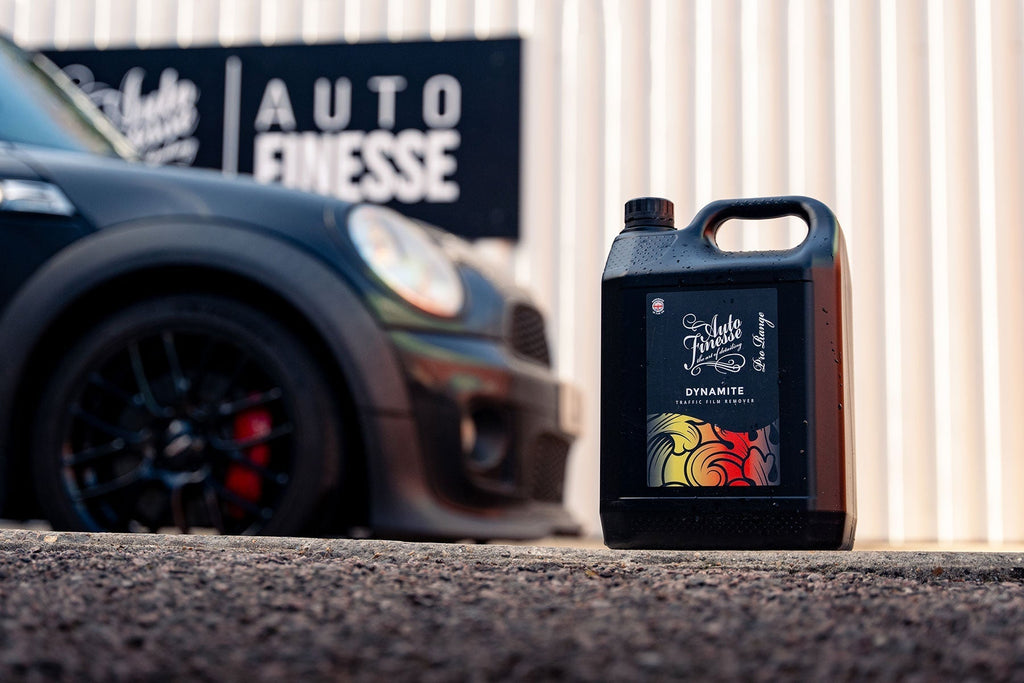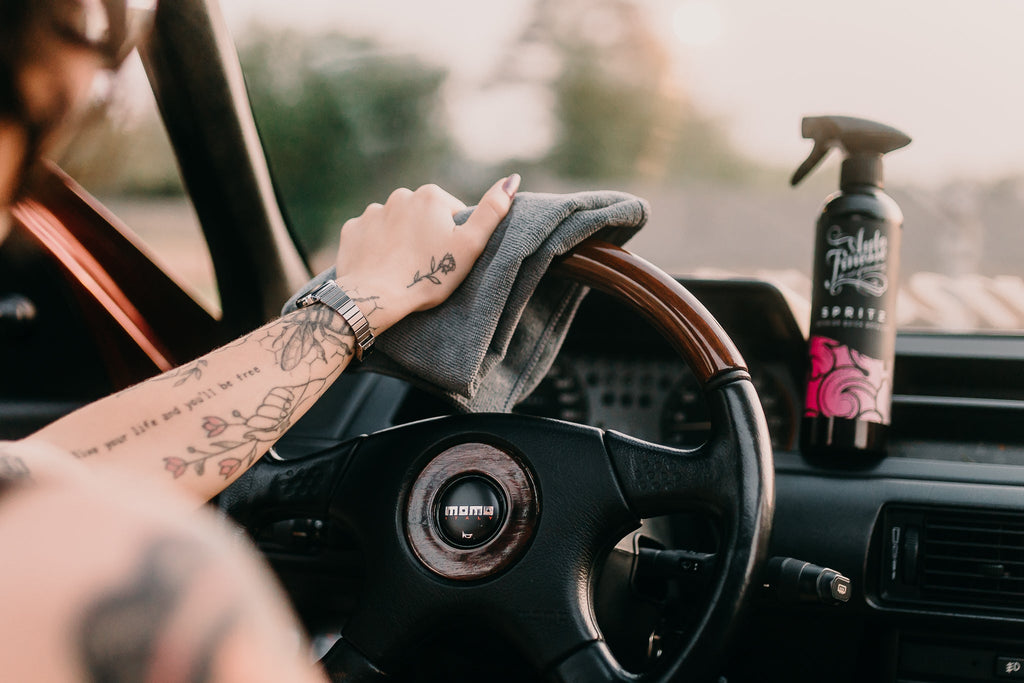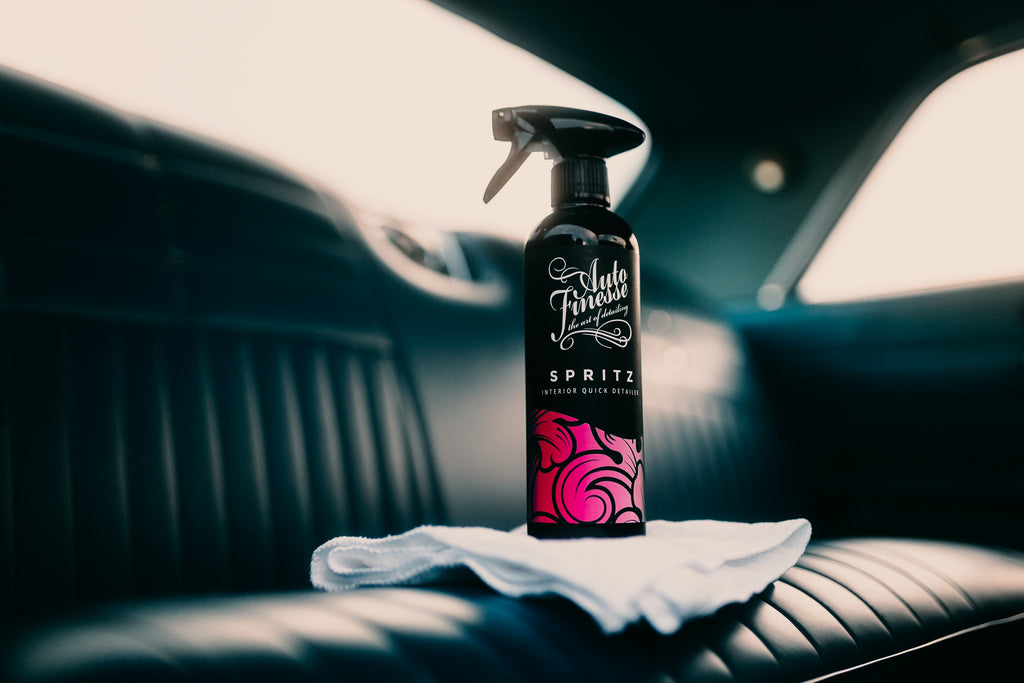How To Restore Plastic Headlights Like A Pro

IN THIS FREE GUIDE:
Discover the professional process to safely restore and protect all types of plastic headlight.
See the detailing products you can use to get the best professional results from specialist stages such as machine polishing, wet sanding and installing ceramic protection.
Learn why headlights fade and how you can ensure they never detract from the rest of your detail.
Whether you’re a detailing enthusiast working on your own car or you’re in the trade and looking to add another professional service to your portfolio, we can help you take care of one of the most often forgotten, yet most noticeable, parts of any vehicle – the headlights.
Now, aside from the obvious safety concerns of being able to see the road ahead - or indeed, letting other road-users see you - faded, discoloured and generally tired-looking plastic headlights can easily let down an otherwise impeccable detail. And, as we all know, anything that draws the eye from the work you’ve put into the rest of your car is never a good thing.
But that’s exactly where we’re here to help. Follow along as we take you through the entire process from start to finish, reveal the essential detailing products to use along the way, and show you how professional detailers not only fully restore faded plastics, but keep them protected from fading and grime ingress in the future…


Why do I need to restore and protect my headlights?
Even on relatively modern vehicles plastic headlights can degrade over time but, aside from letting down your detail or simply making your whole car look tired, they cause an obvious issue with safety. Here in the UK at least the MOT regulations around faded, discoloured lenses are particularly stringent and it’s not just that, they can also land you in hot water with the authorities. According to the highway code (Rule 226), "You must use headlights when visibility is seriously reduced", so if you’d like to avoid a hefty fine, it’s important to ensure your headlights are working to their full potential.
Discoloured headlight housings are more common than you may think, and the common misconception that these problems are limited to Japanese imports isn’t the case. While they do tend to suffer more than most, plenty of other cars can present a similar challenge for car owners and detailers.
But, with all that said, faded headlights aren't necessarily a cause for concern.

Why do headlights fade?
Since the early 2000s many vehicle manufacturers have opted to use soft plastics for headlight lenses as opposed to glass, mainly to reduce weight but also to cut down on production costs. We see headlight lenses become cloudy for several reasons including oxidation, engrained dirt and exposure to UV, along with simple neglect and general wear and tear. While the way we tackle the restoration itself remains the same, it’s good to know how the damage is caused, so we can keep them in tip top condition in the future.
Oxidation causes the degradation of the clearcoat applied to your lenses at the factory. Much like on paintwork, this top layer of lacquer is designed to protect what’s underneath, in this case the bare plastic surface. Over time the clearcoat reacting with the oxygen in the air causes the molecules to bond together to create a misty, faded top layer. It’s exactly the same process that causes unprotected metal surfaces to rust. This oxidation in the clearcoat, or any exposed plastic, eventually eats further and further into the surface, meaning the more faded your headlight, the more you’ll have to level them down to clear through the oxidation layer and get to fresh plastic or clearcoat.
Most headlights will have this physical layer of protection applied when they are manufactured, but over time clearcoat can break down and cause discolouration or light cracks in the headlight lens. The problem is compounded by exposure to UV which, as your headlights are on the exterior, can’t really be helped with anything but adding UV resistant protection. Over time it’s also inevitable that the lacquer will break down when exposed to heavy-duty cleaning chemicals or bad wash techniques, and this can often lead to dirt ingress as potentially corrosive contamination bonds with the clearcoat or (even more readily) to any exposed plastic. Whether it’s neglect from infrequent cleaning, or simply a lack of hydrophobic protection that allows water and grime to stick fast, these are all problems that can make you headlights appear tired, damaged and faded.

What does restoring headlights involve?
As with any other part of your car - the paintwork being the prime example - you can use a combination of deep-cleaning agents and abrasives to restore the surface, and with that add a whole load of shine.
Scratched and oxidised surfaces reflect light in different directions which creates a dull appearance. By removing these defects - whether that’s through intense chemical deep-cleaning or levelling down through scratches and swirls - essentially you’re making the surface reflect light more uniformly to give the appearance of more depth and shine. This is the science of polishing any surface from paintwork and bare metal, to gloss plastic trim. The only difference with headlights is that partially or fully stripping away the top layer of damaged lacquer may be necessary, and sometimes that will take you down to the plastic itself. For the most part professional techniques are needed using the coarsest abrasives to cut through effectively before refining the finish. While lighter restorations may only require hand or machine polishing, most often wet sanding is the only option for the initial cutting phase, much like tackling deeper scratches on paintwork. Instead of taking away just a few microns of the top layer, you may need to take away much more to get thorough the old clearcoat or heaver defects. It’s also easy to see why it’s even more important to add suitable protection layers to seal in the finish… but we’ll get to that.

What detailing products do I need to restore my headlights?
As we said, it is possible to restore plastic headlights by hand, but for the easiest and most consistent results we’ll look to a machine polisher to break down and work through our polishing compounds. Our MPX Dual Action Machine Polisher is ideal for this task because it comes complete with a 3-inch backing plate, making it great for use on these relatively small areas, many of which are contoured. The MPX is also perfect because of the random orbital action which cuts down on heat build-up under the pad – particularly important when you’re polishing plastics.
When you polish any surface the combination of the compound and pad working together is what breaks down your abrasives on a molecular level. Compounds contain tiny abrasive particles of a particular grade and, as your polisher spins, essentially you’re smashing the particles together so they get smaller and smaller. Their ability to cut into to the surface for defect removal gets less and less as they’re broken down, and they go on to lighter cutting (otherwise known as refinement) according to how small there able to break down. At that point, if the surface is flawless enough, you can move on to adding protection to keep it that way. If however, the surface could do with further refinement, we use a series of finer compounds and repeat the process to get the best finish.
With many lighter polishes and compounds it is possible to carry out the working through process by hand, but as you can imagine that takes significant energy to fully break down the abrasives. Using a machine polisher takes away the effort and allows you to concentrate on getting the best, and most consistent, result.

As for the compounds and polishes themselves, the products you need will always depend on the extent of the defects you’re looking to remove. In most cases headlights will require a significantly heavy cut to get through the defects, and then you’ll need to refine the surface to flawless. This could require multiple stages using finer and finer abrasives, such as those found in our Pro Series Polishing Compounds and Revitalise V2 System Compounds, or could be a single stage affair using One Step Compound. All of which are designed for use with a machine polisher.
On the most severely damaged headlights - as with this Supra we’ve drafted in for a demo - wet sanding is the first process we’ll use. Technically this is another polishing process, just with far heavier abrasives designed to cut away more of the top layer. After wet sanding, working down to finer and finer grades of paper, we’ll follow by cutting and refining the surface with our machine polisher in a similar way as we would when removing fine scratches and swirlmarks from paintwork.
Preparation
Preparation, as always, is key when carrying out any correction process. First, the surface to be treated has to be as clean as possible, something to be considered when you wash your and decontaminate car thoroughly. Ideally, use a pure cleaner such as Lather Car Shampoo during your contact wash. This powerful shampoo contains no protectants or shining agents which is ideal because we’re not looking to install any protection at this point, you’ll have to polish it away anyway. When it comes to headlights we also recommend a spot of secondary cleaning after you’ve finished your wash, just to make sure.
Using a 1:5 dilution of Verso All Purpose Cleaner and a soft Detailing Brush is the best way to deep-clean and degrease the surface. Pay particular attention to around the lights including any rubber seals. The aim is to ensure that no grit can be pulled out and swirled around on your polishing pads, potentially causing more damage.
When you’re sure the surface is clean and dry, use Masking Tape around any edges. This not only protects any portions of paintwork that are a little too close for comfort, but protects rubber seals from compound staining and your machine polishing pads from catching.

Wet Sanding
In many cases plastic headlights can be freshened up and brought back to life with nothing more than your machine polisher and compounds. Because of the level of damage on these lights though, we’ll be wet sanding for the initial cutting stages. As we said this is like polishing, just a bit heavier than with the abrasives used in correction products used for detailing.
The key here is to only apply light pressure light and keep the surfaces wet so the paper glides freely – let the abrasives do all the work. A Pro Mixing Bottle and clean water with a drop of Lather for extra lubrication is your friend here. Keep spraying on the soapy solution as your work.
Here we’re using a 4-stage process, starting with 1500-grit paper, followed by 2000, 2500 and 3000-grits. It’s a similar idea to using ever finer compounds to cut and refine paintwork. In fact, it’s exactly the same idea.
We can of course use a random orbital sander here, but for safety sake we’ll complete this part of the process by hand, they are extremely heavy abrasives, after all. As we work through the different grades of wet and dry paper, the cut gets less and less and the finish gets more and more refined as deeper scratches are levelled down and replaced with lighter scratches. As well as getting less hazy as you work, the surface will also get smoother and smoother to the touch.
A top pro tip is to work in straight lines to prevent inflicting swirls. It’s also best to follow one direction (side-to-side) for your first grade of paper, and the opposite direction (top-to-bottom) for the next. Other that periodically clean down the lens with your soapy solution and a microfibre Work Cloth.












From Verso All Purpose Cleaner to Imperial Wheel Cleaner, the Auto Finesse® 1-Litre Pro Range mixing bottle is the perfect product for mixing up and diluting... See product details More
Machine Polishing
Now we can move onto the machine polishing stage where we’ll use our abrasive compounds to cut out the sanding marks and refine the surface down to a smooth, flawless finish. Essentially all we’re doing here is carrying on using abrasives of even finer and finer grades until the clearcoat or plastic is free of visible scratches.
Although we could use a series of finer compounds for this process, too. A single-stage polish should be sufficient to get the professional results we’re after without taking a whole lot of time and effort… it just needs to be the correct compound. That’s why we’re breaking out our One Step Compound, this advanced single stage polish is different to traditional compounds because the special diminishing abrasives it contains have a far wider range of cut. It the real world this means that they break down further. One Step starts off as a heavy cutting compound and breaks down to a fine finishing compound as you work it through. It’s spot on for single stage paintwork corrections, and also great for tackling plastic surfaces, too. One Step eliminates the need for changing compounds and pads. In this case a medium grade Revitalise Spot Pad is ideal for the whole process.
One other thing to remember is that polishing plastics is slightly different to polishing paint. Plastics dissipate heat differently to metal surfaces, they tend to hold on to it for longer. So, while our polishing is extremely similar to polishing regular paintwork, we’ll use a lower speed and pass over the surface a little more quickly to cut help eliminate the chance of scorching the surface. It’s the same process you’d use for Restoring Any Gloss Plastic Trim.
This time around we’ll work in a crosshatch motion over the whole surface making a few passes to ensure the One Step is fully worked through, before buffing away any residue with a clean Work Cloth.












The ultimate single-stage car polish for paint correction, One Step All-in-One Compound is a speedy car detailing game-changer that offers the easy way to remov... See product details More
Installing Protection
As we said, installing protection here is just as vital as anywhere else on your car. This process not only locks in the refinement work your put in, but protects from chemicals and air friction, it also stops grime from sticking, keeping your headlights cleaner for longer. Your protection layers also help to level the optical finish for even more intense shine.
The best way to protect plastic headlights for the long term is using an ultra-hydrophobic ceramic coating. Rather than physically bonding (or simply holding on) to surfaces these professional detailing solutions chemically bond to offer the most durable protection available.
The Si02-based coating in our Caramics Paintwork Protection Kit lasts for up to 12-months and will chemically bond to clear coat or plastics, which makes it ideal for any kind of plastic headlight, especially if the damaged lacquer has been removed. By sealing the surface with a super-shiny layer of clear silicone dioxide (SiO2 - otherwise known as silica and the main ingredient in glass) you get a barrier that’s impermeable to water, grime and even air. This stops oxidation and even protects from UV radiation. In other words, with our Caramics Paintwork Protection Kit you can give your plastics the same level of protection and hydrophobic performance as your paintwork.
Best of all we’ve developed our coating to be easy to use without the need for professional training. The coating is applied using specially impregnated Ceramic Wipes, and the comprehensive kit also contains a solvent-based Prep Spray to make sure you have the optimum surface for ceramic bonding. Simply spritz on your Prep Spray and wipe away any residue with a clean microfibre. Apply your coating in a crosshatch method with your Ceramic Wipe and buff away the residue for a crystal-clear, and fully protected, finish. That’s it. Now you can marvel at the results safe in the knowledge that your headlights will look this good for a whole year.














The ultimate in long-lasting ceramic coating protection and gloss for your vehicles paintwork that lasts up to 12 months. Caramics ceramic coat technology bon... See product details More
Routine Maintenance And Topping Up Protection
What’s also great to know is that routine maintenance and topping up protection to prolong its life and performance couldn’t be easier – you even have a choice of ceramic-infused products to keep your headlights and their ceramic protection in tip top condition.
During maintenance washes your usual safe-wash routine shouldn’t change. Be sure to use the correct wash techniques including a through pre-wash process using protection-safe cleaning agents such as Citrus Power Bug & Grime Remover, Dynamite Traffic Film Remover and Avalanche Snow Foam. These won’t strip or degrade your ceramic coating. Check out our article on How To Safely Wash A Car.
During your contact wash you can swap out your shampoo solution for Caramics Enhancing Shampoo which is specifically designed to strengthen SiO2-based coatings, or if you prefer you can top up the shine and protection before you dry using Lavish Ceramic Foam… or after you dry with Ceramic Spray Wax or Caramics Gloss Enhancer.
The point is that, whether you’d like to strengthen your coating during your contact wash, via you Snow Foam Lance or with just a spritz and wipe at the end of your detail, it’s all up to you. Just rest assured that our ceramic-infused protection products make keeping the shine and the all-important hydrophobic performance quicker and easier than you might think.

So, that's how you can restore and protect your plastic headlights like a pro, and all in just a few simple steps.
For more top detailing guides, check out the Guides Section Of Our Blog.








































